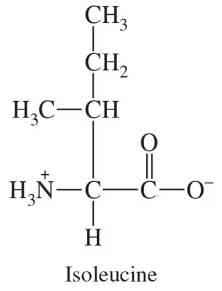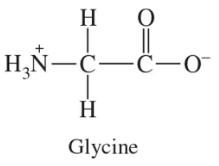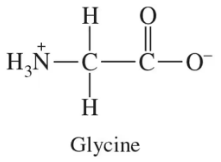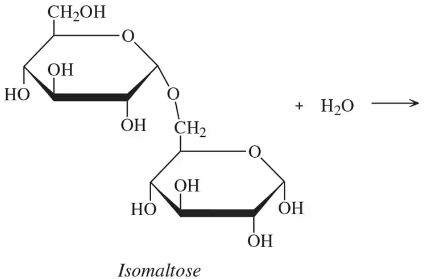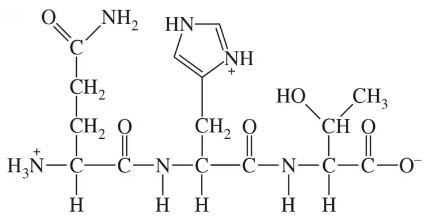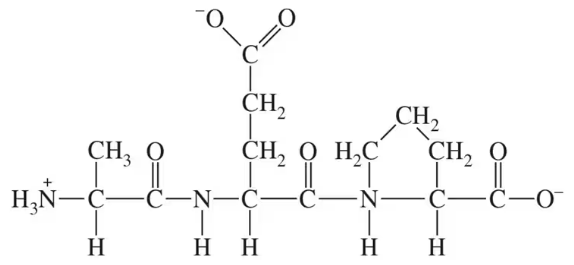 Back
BackProblem 1b
Draw the structure for each of the following amino acids and put an asterisk (*) next to any chiral carbon centers in your structure:
b. lysine
Problem 2
Classify each of the amino acids in Problem 10.1 as polar (neutral, acidic, or basic) or nonpolar and as hydrophobic or hydrophilic.
a. alanine
b. lysine
c. tryptophan
d. aspartate
Problem 3
Give the three-letter and one-letter abbreviations and identify the functional group in the side chain for each amino acid in Problem 10.1.
a. alanine
b. lysine
c. tryptophan
d. aspartate
Problem 4c
Draw the structure for each of the following amino acids and put an asterisk (*) next to any chiral carbon centers in your structure:
c. methionine
Problem 5
Classify each amino acid in Problem 10.4 as polar (neutral, acidic, or basic) or nonpolar and as hydrophobic or hydrophilic.
a. leucine
b. glutamate
c. methionine
d. threonine
Problem 7c
Draw the structure for the amino acid represented by each of the following abbreviations:
c. Q
Problem 7d
Draw the structure for the amino acid represented by each of the following abbreviations:
d. Ile
Problem 8c
Draw the structure for the amino acid represented by each of the following abbreviations:
c. Val
Problem 8d
Draw the structure for the amino acid represented by each of the following abbreviations:
d. Y
Problem 11b
Isoleucine has the zwitterion structure shown. Draw the structure and give the net charge of isoleucine that will predominate at the indicated pH values (pI = 6.0).
b. pH 6.0
Problem 12a
Glycine has the zwitterion structure shown. Draw the structure and give the net charge of glycine that will predominate at the indicated pH values (pI = 6.0).
a. pH 1.5
Problem 12b
Glycine has the zwitterion structure shown. Draw the structure and give the net charge of glycine that will predominate at the indicated pH values (pI = 6.0).
b. pH 12.0
Problem 13a
Write the products for the following condensation or hydrolysis reactions:
a.
Problem 14a
Write the products for the following condensation or hydrolysis reactions:
a.
Problem 15a
Consider the following tripeptide:
a. Circle the N-terminal amino acid, and give its name. Draw a square around the C-terminal amino acid, and give its name.
Problem 16b
Consider the following tripeptide:
b. Give the one-letter and three-letter abbreviations of this tripeptide.
Problem 17b
Draw the structural formula for each of the following peptides:
b. KCG
Problem 17c
Draw the structural formula for each of the following peptides:
c. His—Met—Gln
Problem 18c
Draw the structural formula for each of the following peptides:
c. Val—Arg
Problem 18d
Draw the structural formula for each of the following peptides:
d. IYP
Problem 20a,b
Identify the N-terminus and the C-terminus for each of the peptides in Problem 10.18.
a. Ala—Asn—Thr
b. DS
Problem 20c
Identify the N-terminus and the C-terminus for each of the peptides in Problem 10.18.
c. Val—Arg
Problem 20d
Identify the N-terminus and the C-terminus for each of the peptides in Problem 10.18.
d. IYP
Problem 22
How many different tripeptides that contain one leucine, one glutamate, and one tryptophan are possible?
Problem 23
Name the stabilizing attractive force found in secondary structures of proteins.
Problem 24
When a protein folds into its tertiary structure, does the primary structure change? Explain.
Problem 25
Describe the differences in the shape of an α helix and a β-pleated sheet.
Problem 26b
What type of interaction would you expect between the side chains of each of the following pairs of amino acids in the tertiary structure of a protein?
b. alanine and valine
Problem 27a
What type of interaction would you expect between the side chains of each of the following pairs of amino acids in the tertiary structure of a protein?
a. lysine and glutamate

